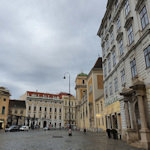Where can you find an abbey, aristocratic palaces, a court, an 18th-century pharmacy and even a contemporary art museum all within a stone’s throw of each other? Answer: the Freyung.
- Historical square in Vienna’s centre
- Originally attached to the neighbouring abbey
- Home to some of the city’s most famous landmarks and buildings
- See also:
History and buildings

(View from the south)
I call the Freyung a square, but it’s more of a “misshaped open space” (I should work in marketing). One that has shrunk and grown through the centuries.
The name echoes a time when the adjoining 12th-century Schottenstift abbey enjoyed immunity from the interference of the city (Frey = Frei = free).
Like many such spaces, the Freyung has a long history as a marketplace that goes back through the centuries. The tradition continues today in the form of a weekly farmers market, but particularly in the popular Altwiener Christmas and Easter events.
Unsurprisingly, the surrounding buildings include a number of historical treasures. Let’s go through them one by one…
Palais Hardegg

(The unusual pastel colour helps the palais stand out from the surrounds)
The first address at number 1 sets an elegant tone: a pale green façade marks one end of Palais Hardegg, built for the same-named count in the middle of the 19th century.
The townhouse extends away from the Freyung down toward Herrengasse, where it backs onto Palais Ferstl.
The Hardeggs kept rooms in the building, but the idea was always to rent out space to tenants. As such, the palais offers an early example of the switch from purely private palatial residences to those built with an eye for their commercial value.
If history had taken a different turn, something quite different might have stood on this site. A bank planned a refurbishment around 1919 which would have included a huge tower block. Some might have called it ugly, others a triumph of modernist architecture. We shall never know.
Ferstel Passage
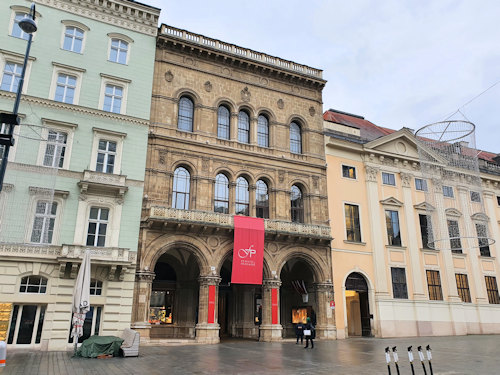
(The lighted passageway makes a lovely impression inside: a kind of renaissance-style double row of upmarket stores and boutiques)
The Ferstel Passage leads from the Freyung through to Herrengasse and forms part of Palais Ferstel.
They completed the wider palais in 1860, though no aristocrat moved in: this was the new home of the national bank and stock market.
Despite the rather important owner, the building’s enduring fame came from another occupant on the ground floor: the currency of exchange in Café Central being ideas, news and gossip, rather than money and shares.
To catch the full glory of the main building, pop through the passage and turn left down Herrengasse. You’ll likely spot today’s Café Central there from the queue outside, since the location counts as one of Vienna’s most popular coffee houses.
Palais Harrach

(The oldest of the palais triumvirate on this side of the Freyung)
The baroque Palais Harrach at number 3 appeared at the end of the 17th century, providing a Viennese home to one of the leading court officials of the time: Count Harrach. This house also extends back to Herrengasse.
Sadly, the location suffered twice from collateral damage. Once in 1683, when a spreading fire from nearby destroyed Palais Harrach’s predecessor. And once in 1944 at the hands of indiscriminate WWII bombing.
Palais Kinsky
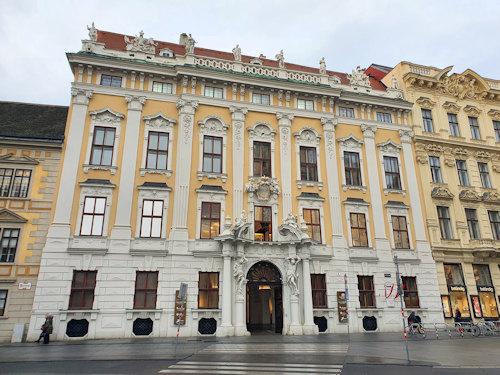
(The best-looking of the various palais buildings lining the Freyung)
Palais Kinsky (sometimes Daun-Kinsky) proved a suitable outlet for a conquering hero (Count Daun) to spend his hard-won war gains on. Built in the early 18th century, the palais counts as a highlight of Vienna’s Baroque architecture.
If you want to add a noble touch to your trip, the location now serves as a prestigious event venue.
Freyung 5

(Marks the start of Teinfaltstraße that takes you to the Rathaus and Burgtheater)
OK, time for a breather.
The building at number 5 is not a palais and has no notable claim to fame that I know of…just a “simple” apartment house constructed in the 1880s.
Not that the location lacks historical pedigree. Back in the 15th century, for example, the butchers had their guild house here.
Abbey and church
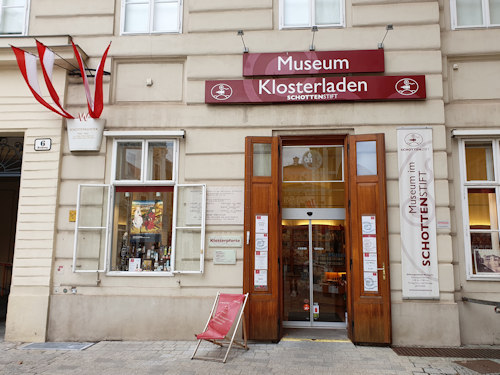
(Shop and museum entrance)
Crossing over the street to the square proper takes you to the southern edge of the Schottenstift abbey complex, first established in the 12th century.
The part you can see from the Freyung is from the 19th century, I believe.
The composer Franz Liszt stayed within the buildings surrounding the first courtyard beyond when visiting Vienna (look for the plaque inside). That same courtyard also has a lovely outdoor area for the traditional Café Diglas coffee house.
To the right of the entrance is the abbey shop, which leads through to the Schottenstift Museum with its collection of art and ecclesiastical artifacts: look for the famous 15th-century altar panels.
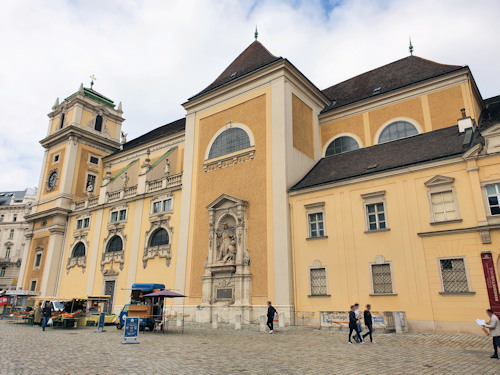
(First consecrated in 1200, the Schottenkirche is now a Baroque masterpiece inside)
Next door is the Schottenkirche abbey church. Follow its outside wall to pass the embedded memorial to Heinrich II. Jasomirgott, the first Duke of Austria and Schottenstift’s founder.
And a little further on (at Freyung 6A), you have the abbey’s public guesthouse and entrance to a chapel that still features some of the original Romanesque church.
The fountain

(The river-themed fountain)
The Austriabrunnen (Austria fountain) at the square’s centre appeared in 1846 towards the end of the reign of the second Emperor of Austria, Ferdinand I.
The top figure represents Austria itself, while the figures lower down represent the four major rivers of the empire at the time:
- The Elbe (mostly now in modern-day Germany)
- The Vistula (modern-day Poland’s longest river)
- The Danube (the only one that still runs through Austria)
- The Po (modern-day Italy’s longest river)
Freyung 7

(Includes a store that dates back almost to the American War of Independence)
The standalone building at number 7 went up in the early 1770s and was apparently intended as an apartment block for rental, even if the neighbouring abbey made use of the premises for their own needs in the early years.
Surprisingly, this building was likely the first ever built here, since the land beneath served for a long time as the abbey’s cemetery.
(So if you hear wailing at night on the Freyung, it might be a tourist who forgot the address of their hotel, or it might be something else entirely.)
Known as the chest-of-drawers house (because of its design) or priory house (because the rooms of the Schottenstift’s prior extended into the building), the building’s ground floor now houses the “Schottenapotheke”.
That pharmacy began life elsewhere on the Freyung in 1782 and moved here around 1837. Its neighbour sells teas, medicinal herbs and similar: the KOTTAS Kräuterhaus first opened here in 1795.
Constitutional Court & Art Museum

(An excellent tip for world-class art exhibitions)
Our final address on the Freyung (at number 8) is a surly toddler in comparison to its older colleagues, though the site itself has a rich history.
The current building appeared in the early 20th century and now houses two important institutions:
- The Bank Austria Kunstforum Wien (a contemporary public art gallery whose major exhibitions bring big names like David Hockney or Helmut Newton to Vienna)
- The Verfassungsgerichtshof (Austria’s Supreme Constitutional Court)
Previous houses at this location included the premises of the pharmacy now at No. 7, but also buildings with such delicious names as (my translation) “to the red man” or “by the painful mother”.

(The court entrance)
The 1721 uprising of journeymen shoemakers (!) apparently started in an inn here, too. Never underestimate trainee shoemakers with an agenda.
How to get to the Freyung
The square is just a few minutes walk from the pedestrianised streets of the old town or across from the Rathausplatz square where so many of Vienna’s big events take place.
Subway: take the U2 line to Schottentor or the U3 line to Herrengasse
Tram/bus: the old town bus line 1A stops at Teinfaltstraße on the Freyung. The tram stop at Rathausplatz/Burgtheater is close by, too (reached by lines 1, D and 71)
Address: Freyung, 1010 Vienna
